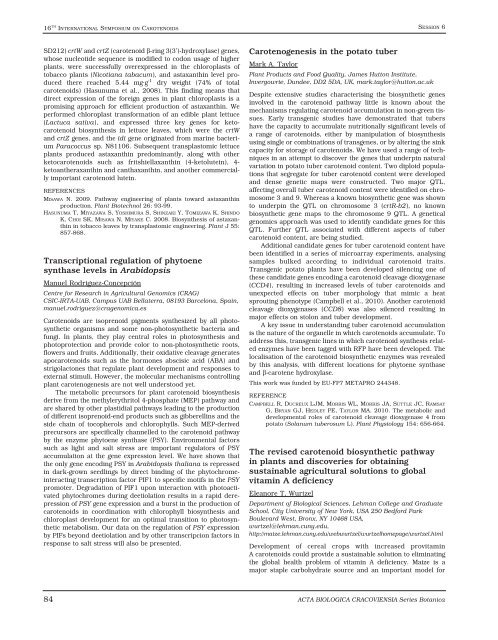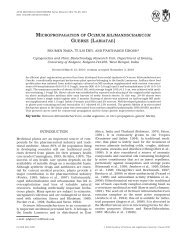ACTA BIOLOGICA CRACOVIENSIA
ACTA BIOLOGICA CRACOVIENSIA
ACTA BIOLOGICA CRACOVIENSIA
Create successful ePaper yourself
Turn your PDF publications into a flip-book with our unique Google optimized e-Paper software.
16 TH INTERNATIONAL SYMPOSIUM ON CAROTENOIDS<br />
SD212) crtW and crtZ (carotenoid β-ring 3(3’)-hydroxylase) genes,<br />
whose nucleotide sequence is modified to codon usage of higher<br />
plants, were successfully overexpressed in the chloroplasts of<br />
tobacco plants (Nicotiana tabacum), and astaxanthin level produced<br />
there reached 5.44 mg·g -1 dry weight (74% of total<br />
carotenoids) (Hasunuma et al., 2008). This finding means that<br />
direct expression of the foreign genes in plant chloroplasts is a<br />
promising approach for efficient production of astaxanthin. We<br />
performed chloroplast transformation of an edible plant lettuce<br />
(Lactuca sativa), and expressed three key genes for ketocarotenoid<br />
biosynthesis in lettuce leaves, which were the crtW<br />
and crtZ genes, and the idi gene originated from marine bacterium<br />
Paracoccus sp. N81106. Subsequent transplastomic lettuce<br />
plants produced astaxanthin predominantly, along with other<br />
ketocarotenoids such as fritshiellaxanthin (4-ketolutein), 4ketoantheraxanthin<br />
and canthaxanthin, and another commercially<br />
important carotenoid lutein.<br />
REFERENCES<br />
MISAWA N. 2009. Pathway engineering of plants toward astaxanthin<br />
production. Plant Biotechnol 26: 93-99.<br />
HASUNUMA T, MIYAZAWA S, YOSHIMURA S, SHINZAKI Y, TOMIZAWA K, SHINDO<br />
K, CHOI SK, MISAWA N, MIYAKE C. 2008. Biosynthesis of astaxanthin<br />
in tobacco leaves by transplastomic engineering. Plant J 55:<br />
857-868.<br />
Transcriptional regulation of phytoene<br />
synthase levels in Arabidopsis<br />
Manuel Rodríguez-Concepción<br />
Centre for Research in Agricultural Genomics (CRAG)<br />
CSIC-IRTA-UAB. Campus UAB Bellaterra, 08193 Barcelona, Spain,<br />
manuel.rodriguez@cragenomica.es<br />
Carotenoids are isoprenoid pigments synthesized by all photosynthetic<br />
organisms and some non-photosynthetic bacteria and<br />
fungi. In plants, they play central roles in photosynthesis and<br />
photoprotection and provide color to non-photosynthetic roots,<br />
flowers and fruits. Additionally, their oxidative cleavage generates<br />
apocarotenoids such as the hormones abscisic acid (ABA) and<br />
strigolactones that regulate plant development and responses to<br />
external stimuli. However, the molecular mechanisms controlling<br />
plant carotenogenesis are not well understood yet.<br />
The metabolic precursors for plant carotenoid biosynthesis<br />
derive from the methylerythritol 4-phosphate (MEP) pathway and<br />
are shared by other plastidial pathways leading to the production<br />
of different isoprenoid-end products such as gibberellins and the<br />
side chain of tocopherols and chlorophylls. Such MEP-derived<br />
precursors are specifically channelled to the carotenoid pathway<br />
by the enzyme phytoene synthase (PSY). Environmental factors<br />
such as light and salt stress are important regulators of PSY<br />
accumulation at the gene expression level. We have shown that<br />
the only gene encoding PSY in Arabidopsis thaliana is repressed<br />
in dark-grown seedlings by direct binding of the phytochromeinteracting<br />
transcription factor PIF1 to specific motifs in the PSY<br />
promoter. Degradation of PIF1 upon interaction with photoactivated<br />
phytochromes during deetiolation results in a rapid derepression<br />
of PSY gene expression and a burst in the production of<br />
carotenoids in coordination with chlorophyll biosynthesis and<br />
chloroplast development for an optimal transition to photosynthetic<br />
metabolism. Our data on the regulation of PSY expression<br />
by PIFs beyond deetiolation and by other transcripcion factors in<br />
response to salt stress will also be presented.<br />
Carotenogenesis in the potato tuber<br />
Mark A. Taylor<br />
Plant Products and Food Quality, James Hutton Institute,<br />
Invergowrie, Dundee, DD2 5DA, UK, mark.taylor@hutton.ac.uk<br />
Despite extensive studies characterising the biosynthetic genes<br />
involved in the carotenoid pathway little is known about the<br />
mechanisms regulating carotenoid accumulation in non-green tissues.<br />
Early transgenic studies have demonstrated that tubers<br />
have the capacity to accumulate nutritionally significant levels of<br />
a range of carotenoids, either by manipulation of biosynthesis<br />
using single or combinations of transgenes, or by altering the sink<br />
capacity for storage of carotenoids. We have used a range of techniques<br />
in an attempt to discover the genes that underpin natural<br />
variation in potato tuber carotenoid content. Two diploid populations<br />
that segregate for tuber carotenoid content were developed<br />
and dense genetic maps were constructed. Two major QTL,<br />
affecting overall tuber carotenoid content were identified on chromosome<br />
3 and 9. Whereas a known biosynthetic gene was shown<br />
to underpin the QTL on chromosome 3 (crtR-b2), no known<br />
biosynthetic gene maps to the chromosome 9 QTL. A genetical<br />
genomics approach was used to identify candidate genes for this<br />
QTL. Further QTL associated with different aspects of tuber<br />
carotenoid content, are being studied.<br />
Additional candidate genes for tuber carotenoid content have<br />
been identified in a series of microarray experiments, analysing<br />
samples bulked according to individual carotenoid traits.<br />
Transgenic potato plants have been developed silencing one of<br />
these candidate genes encoding a carotenoid cleavage dioxygenase<br />
(CCD4), resulting in increased levels of tuber carotenoids and<br />
unexpected effects on tuber morphology that mimic a heat<br />
sprouting phenotype (Campbell et al., 2010). Another carotenoid<br />
cleavage dioxygenases (CCD8) was also silenced resulting in<br />
major effects on stolon and tuber development.<br />
A key issue in understanding tuber carotenoid accumulation<br />
is the nature of the organelle in which carotenoids accumulate. To<br />
address this, transgenic lines in which carotenoid synthesis related<br />
enzymes have been tagged with RFP have been developed. The<br />
localisation of the carotenoid biosynthetic enzymes was revealed<br />
by this analysis, with different locations for phytoene synthase<br />
and β-carotene hydroxylase.<br />
This work was funded by EU-FP7 METAPRO 244348.<br />
SESSION 6<br />
REFERENCE<br />
CAMPBELL R, DUCREUX LJM, MORRIS WL, MORRIS JA, SUTTLE JC, RAMSAY<br />
G, BRYAN GJ, HEDLEY PE, TAYLOR MA. 2010. The metabolic and<br />
developmental roles of carotenoid cleavage dioxygenase 4 from<br />
potato (Solanum tuberosum L). Plant Physiology 154: 656-664.<br />
The revised carotenoid biosynthetic pathway<br />
in plants and discoveries for obtaining<br />
sustainable agricultural solutions to global<br />
vitamin A deficiency<br />
Eleanore T. Wurtzel<br />
Department of Biological Sciences, Lehman College and Graduate<br />
School, City University of New York, USA 250 Bedford Park<br />
Boulevard West, Bronx, NY 10468 USA,<br />
wurtzel@lehman.cuny.edu,<br />
http://maize.lehman.cuny.edu/webwurtzel/wurtzelhomepage/wurtzel.html<br />
Development of cereal crops with increased provitamin<br />
A carotenoids could provide a sustainable solution to eliminating<br />
the global health problem of vitamin A deficiency. Maize is a<br />
major staple carbohydrate source and an important model for<br />
84 <strong>ACTA</strong> <strong>BIOLOGICA</strong> <strong>CRACOVIENSIA</strong> Series Botanica












